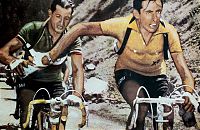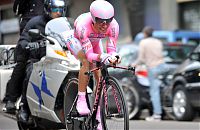Velo Power

“Glide Along Little Lassie”
The bicycle, according to scholar Donald Zaldin, revolutionized nineteenth-century culture. Its progenitor was the two-wheeled velocipede, invented in 1817 by Germany’s Baron Karl von Drais. The velocipede looked like a bike, but it had no crankshaft or drive train. The rider was propelled along by foot power alone. Then, sometime in the mid-1860s, a French metalworker figured out how to add a crankshaft. Two decades later, in 1885, England’s John Kemp Starley attached gears to the rear wheel instead of the front. Three years later, John Boyd Dunlop, a Scottish veterinarian, improved pneumatic tires and introduced the smooth ride. Suddenly, anyone, rich or poor, young or old, could travel beyond his or her immediate surroundings at no extra cost and with little wear on the body. The past century has seen numerous design upgrades and innovations — the three-speed Raleigh, the ten-speed derailleur, the mountain bike, the hybrid — but the concept remains the same.
And that concept’s irreducible nut is the body defying gravity. Riding is governed by physics, specifically by torque-induced precession. Gravity causes a stationary bike to fall over, but applying torque — using the legs and feet to push down on two pedals attached to a crank — changes the equation. The drive train transfers the rider’s energy directly into movement. The wheels turn and stay upright, and torque allows 182 pounds of human tissue to move on two flimsy pieces of rubber filled with air.
The thinner the bicycle’s frame, the less wind resistance, and aerodynamics only increases efficiency; leaning over the handlebars, especially going downhill, reduces drag and boosts speed. Spoked wheels are almost as strong as solid ones, at a fraction of the weight. Using a derailleur, a transmission system invented by the French in the late nineteenth century, the rider easily switches the chain to a smaller sprocket and — voila! — more torque, more distance in less time. As the rider increases cadence — the number of revolutions per minute — he injects pure power, especially in higher gear ratios. The work is hard but satisfying.
Source – Switching to Glide
<< Contrail | Heavy Metal >>












